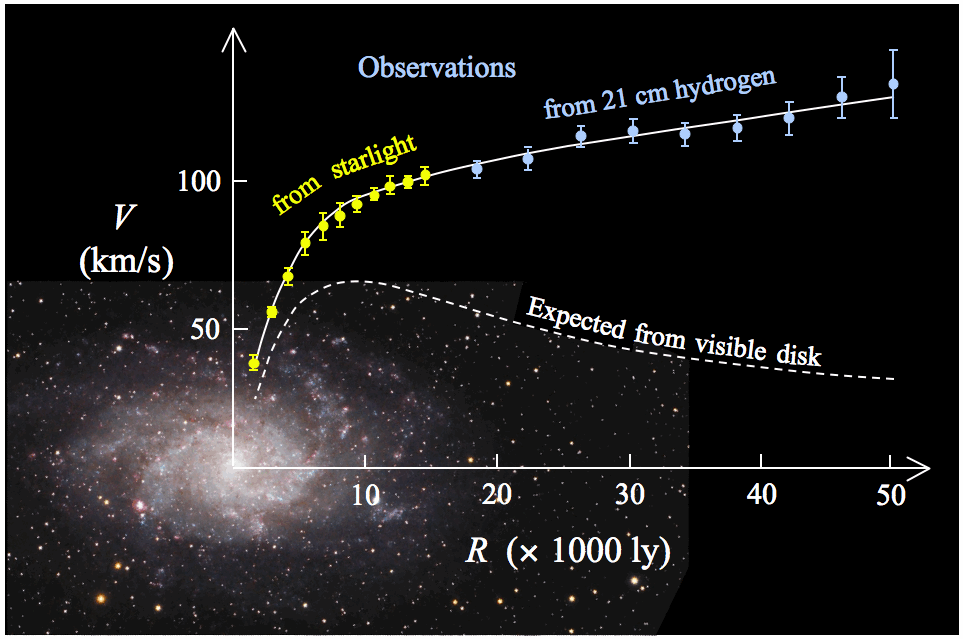When we think about the type of matter that makes up the majority of our universe, we tend to say it is baryonic (stars, gases, galaxies, planets, and dust). While it is true that baryonic matter makes up a notable proportion of all the matter in the universe, scientists have recently theorized that there is a new type of matter, dark matter, that constitute up to 85% of all the matter in the universe. Yet, they are not able to obtain a hard evidence to prove this claim.
The reason why scientists call this matter Dark is because it has not been detected by any of the Earth-based detectors. Even though, it must be there because it exhibits an associated mass that needs to be accounted for to explain the observable universe. In this article, we will further understand what dark matter is and discuss the techniques that scientists are using to detect it.
Notable Evidence for Dark Matter
One of the most notable exhibits that scientists have in regards to the existence of dark matter came from observing the rotation curves of galaxies. Powerful radio telescopes are used to map the motion of stars within a galaxy. By measuring the velocity of the stars relative to the galactic center, scientists concluded that the stars positioned far from the center rotate much faster than what is predicted from Kepler’s third law. Hence, they theorized that there must be some additional mass (matter) that is causing the stars to rotate at such abnormal rotational velocities. They called this dark matter. The following figure shows the observed velocity curve of stars relative to the galactic center and compares that to the expected curve. It is evident that some excess mass is causing stars to rotate much faster than expected.

The purpose of this illustration is to show the discrepancy of radial velocity of stars that scientists observe to the expected velocities. The dashed line represents the expected velocities of stars, which was derived using Newtonian mechanics.
A Possible Candidate: WIMPs
Even though scientists have not yet found direct evidence for the existence of dark matter particles, they have proposed a couple of candidates. One such leading candidate is the Weakly Interacting Massive Particle (WIMP). A WIMP is a hypothetical particle that interacts via gravitational forces that are weaker than the weak force. In the early universe, all the particles were in thermal equilibrium. During that period, theory goes, the high temperatures would have caused dark matter (particle/antiparticle pairs) to form and annihilate into lighter particles. Eventually, the universe expanded and cooled and caused the thermal energy of these lighter particles to decrease, making it insufficient to form further dark matter particle-antiparticle pairs.
However, the annihilation of dark matter particle-antiparticle would have continued, decreasing their density exponentially. Eventually, the density of these particles would have become so low that the particle-antiparticle interaction ceased, making their numbers remain constant in the universe. Today, it is estimated that dark matter exists all around us but goes by undetected because of their small interaction cross section. In particular, it is estimated that the interaction cross section for these hypothetical particles is less than the cross section for the weak interaction. If this theory is correct, then WIMPs can serve as a good candidate for dark matter.
Detection Methods
There are two detection methods that are currently being used to detect WIMPs: direct and indirect. Just as the name suggests, direct detection implies observing recoil pattern in the nucleus of atoms caused by WIMPs. In particular, similar to the Compton Scattering, scientists here try to trace the collisional effects resulting from the interaction of dark matter particles and nucleus. It is theorized that the collision would emit a lot of phonons. Since phonons can only be detected using highly sensitive apparatus, the laboratories conducting this experiment are located well underground. One of the most renowned site where this experiment is taking place is called Gran Sasso National Laboratory, which is located in Italy.

Gran Sasso National Lab, Italy. Image Courtesy of California Polytechnic State University, San Luis Obispo
On the other hand, indirect detection techniques focus on observing gamma rays or standard model particle-antiparticle pairs produced from the annihilation of dark matter particles. When dark matter pass through celestial bodies like Earth or the sun, they lose most of their kinetic energy and start accumulating near the center of the body. The large density of dark matter particles induces self collision/annihilation. The annihilation of dark matter particles results in the production of gamma rays and high energy neutrinos. Telescopes that are currently in search of the signal produced from the collision/annihilation of dark matter are Antarctic Muon And Neutrino Detector Array (AMANDA), IceCube Neutrino Observatory, and ANTARES.
Summary
To scientists, dark matter acts as a set of hypothetical particles that can be used to explain the discrepancies seen in the radial velocities of stars. However, no concrete evidence has yet been shown that proves the existence of such particles. WIMPs can serve as a good candidate for dark matter particles, however, their existence has not been proved yet either. Several laboratories and observatories are currently on a quest to discover dark matter by using direct and indirect detection techniques. If scientists were to discover dark matter, then it would become one of the biggest discoveries of all time shedding light on observed anomalies in our universe and potentially giving rise to a new field in particle physics.
Further Reading
- Dark Matter – Wikipedia, https://en.wikipedia.org/wiki/Dark_matter
- Galaxy Rotation Curve – Wikipedia, https://en.wikipedia.org/wiki/Galaxy_rotation_curve
- Dark matter detection methods – https://www.sciencedirect.com/science/article/pii/S2212686412000106
